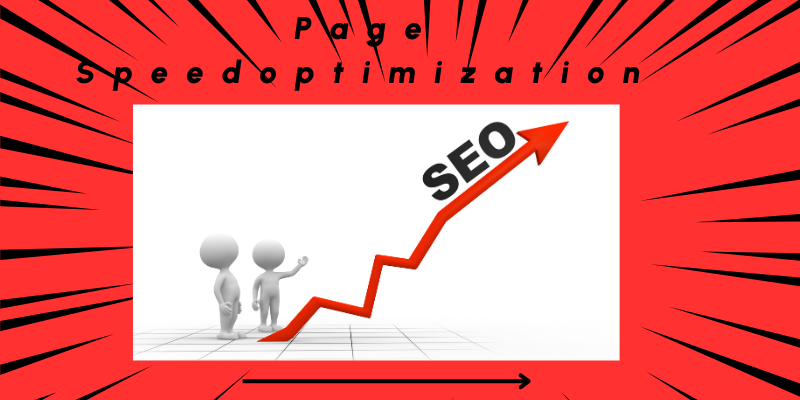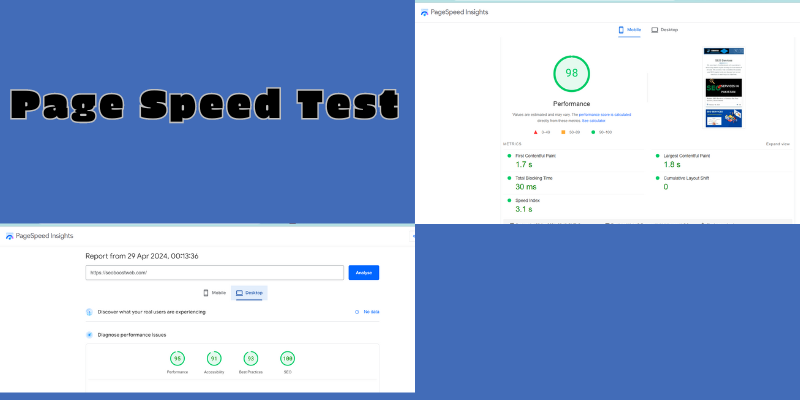What is Page Speed | Why page speed is important for SEO?
Updated: April 28, 2024
97
Page speed refers to the time a web page’s content takes to load fully and display to the user. It is a critical factor in SEO (Search Engine Optimization) as it directly impacts user experience and website ranking on search engine results pages (SERPs).

Page site speed, or load speed, is not just a number. It’s the difference between a user-friendly website and a frustrating experience.
Slow page speed can lead to high bounce rates, low session durations, and poor user satisfaction.
Page speed is critical because it influences website performance and user interaction.
User Satisfaction
A fast-loading website enhances user satisfaction by providing a smooth and efficient browsing experience. Users are more likely to engage with and return to websites that load quickly and respond promptly to their actions.
Session Duration
Improved page speed contributes to longer session durations as users explore the website’s content more. Longer sessions indicate higher engagement and interest, impacting average session duration and pages per session.
Bounce Rate Reduction
Faster page loading times help reduce bounce rates, which refers to the percentage of visitors who navigate away from the website after viewing only one page. A lower bounce rate indicates visitors find the content relevant and engaging, leading to better website performance.
Search Engine Ranking
Page speed is not just a user preference; it’s a ranking factor. Search engines like Google prioritize websites with fast load speeds in their ranking algorithms.
So, improving your page speed can significantly boost your website’s visibility and organic traffic. Achieving optimal page speed involves various optimization techniques, including
- Content and image optimization,
- Efficient coding,
- Browser caching,
- and minimizing server response times.
By diligently improving page speed, website owners can enhance user experience, reduce bounce rates, and significantly boost their ranking and performance in search engine results.
This proactive optimization approach empowers you to control your website’s destiny.
Ready To Take the First Step Toward Optimizing Your Website’s Speed?
Conducting a speed test on our website is a great way to start. It provides insights into what’s working well and what needs improvement. Let’s proceed with the speed test here.
In this test, we evaluate a website’s speed. If a website loads slowly, users are less likely to prefer it.
Everyone desires quick website loading times. A website that is slow to load can deter users, potentially leading to various issues.
Have you Ever Wondered What Could be Causing the Delay?
Speed Optimizing the website is necessary.
Google offers a tool for testing website speed load, available at web.dev.com.
After conducting a speed test, I noticed that the speed varies between mobile and desktop.
The tool diagnoses the website, indicating it’s actively checking and assessing its performance. Rest assured, this test is a reliable way to determine if the speed improves, giving you a clear path to enhancing your website’s performance.
What is the Ideal Page Loading Speed?

The site should ideally load within 3 seconds. If it takes more than 5 seconds, prioritize checking the website’s speed over keyword research or other tasks.
Start by assessing the SSL certificate status. A slow website can hinder ranking as Google prioritizes faster-loading sites. Ensure your website is optimize for speed; Google does not favour slow websites in ranking.
Verify the presence of HTTPS in the URL.
SSL awareness is essential for all users. After optimizing the website speed, tools like Google PageSpeed Insights and Gtmetrix can measure and improve performance.
Does Page Speed Affect SEO?
VPS and WordPress Hosting for Site Speed Load
If you want to optimize your website, ensure you have reliable hosting. Consider VPS or specialized WordPress hosting, as they are optimized for WordPress sites.
This ensures better performance and stability.
Once you have chosen the appropriate hosting, focus on other optimization steps such as:
- Caching: Implement caching mechanisms to reduce server load and improve page load times.
- Content Delivery Network (CDN): Utilize a CDN to distribute your website’s content across multiple servers worldwide, reducing latency and improving loading speeds for users globally.
- Image optimization: Compress images to reduce file sizes without compromising quality, improving load times.
- Minification: Minify HTML, CSS, and JavaScript files to reduce their size and decrease load times.
- Browser caching: Configure caching headers to instruct browsers to cache static resources, reducing the need for repeated downloads.
- Optimize plugins and themes: Regularly update and optimize them to ensure they are not causing performance issues.
- Database optimization: Optimize your website’s database by removing unnecessary data, optimizing queries, and scheduling regular clean-ups.
- Reduce HTTP requests: Minimize the number of HTTP requests by combining and reducing the size of CSS and JavaScript files and using CSS sprites for images.
- Mobile optimization: Ensure your website is responsive and optimized for mobile devices to provide a seamless experience across all devices.
- Regular monitoring and maintenance: Continuously monitor your website’s performance using tools like Google PageSpeed Insights and GTmetrix, and regularly perform maintenance tasks to keep it running smoothly.
Page Speed Key Metrics for SEO?
Let’s consider this from Google’s perspective.
- A website with a performance score of 90 is considered good, indicated by a green status.
- Scores between 50 and 89 suggest room for improvement.
- If the score falls between 0 and 49, it implies significant issues that need addressing.
- Aim to maintain a score of 90 or above to stay in the green zone. Achieving a green status on the desktop is more straightforward than on mobile devices.
What are Core Web Vitals?
Now, let’s delve into the core web vitals metrics that measure speed elements:
- FCP (First Contentful Paint),
- LCP (Largest Contentful Paint),
- CLS (Cumulative Layout Shift),
- TPT (Time to Interactive),
- And SI (Speed Index).
Largest Contentful Paint (LCP)
This metric measures the loading speed of the most significant content element (images or videos) within a web page’s viewport. LCP provides insights into users’ perceived loading experience, indicating when the main content becomes visible. Tools like Google PageSpeed Insights and Lighthouse analyze LCP to assess page performance.
First Input Delay (FID)
FID measures the time it takes for a web page to respond to the first user interaction, such as clicking a button or tapping a link. It quantifies the page’s responsiveness and interactivity. A low FID indicates a faster response time, leading to a smoother user experience. FID is often evaluated using tools like Google PageSpeed Insights, Lighthouse, and WebPageTest.
Cumulative Layout Shift (CLS)
CLS measures a web page’s visual stability by quantifying the number of unexpected layout shifts during page loading. Layout shifts can occur when elements on the page (such as images or ads) dynamically change in size or position, causing content to move unexpectedly. CLS aims to ensure a consistent and predictable user experience.
Tools like Google PageSpeed Insights and Lighthouse analyze CLS as part of their performance assessments.
After conducting a speed test, I noticed that the speed varies between mobile and desktop. The tool diagnoses the website, indicating it’s actively checking and analyzing its performance. Take the test yourself to determine if the speed improves.
Improve page speed and user experience, allowing them to optimize their websites for better performance and enhanced user satisfaction.
Does Page Speed Affect SEO?
VPS and WordPress Hosting for Site Speed Load
If you want to optimize your website, ensure you have reliable hosting. Consider VPS or specialized WordPress hosting, which is optimized for WordPress sites and provides better performance and stability.
Once you have chosen the appropriate hosting, focus on other optimization steps such as:
| Here’s the revised technical checklist |
|---|
|
Each element is crucial in ensuring optimal website performance, user experience, and search engine visibility. Implementing these optimization techniques can significantly improve your website’s speed and performance. The second step is to install a cache plugin on your website. Page size is crucial for speed, so optimizing it is essential. Utilize image compression tools to reduce the size of website images. Consider plugins like WP Smush or Imagify for comparison or evaluation. Use plugins like TinyPNG or WP Rocket with recommended settings to optimize speed further. These plugins are designed to enhance website speed optimization and are beneficial in achieving optimal performance.
How to Optimize Page Speed?
Afterwards, there are notable advantages to creating our website on platforms like WordPress, Shopify, or Wix.
These platforms are inherently SEO-friendly; WordPress, often dubbed the industry standard, powers around 43 per cent of websites worldwide.
Its popularity stems from its user-friendly interface and extensive plugin ecosystem.
When we choose WordPress, technical SEO becomes considerably more manageable. Approximately 80% of our website’s technical SEO can be efficiently managed.
However, if we opt for a custom-built site, issues within the coding can pose significant challenges.
We should look at our website in terms of technical and search engine-friendly.
The thing is that Google’s crawler will come, Bing’s crawler will come, or Yahoo’s crawler will come. I want to ensure that when Google crawls our website, indexing should be no problem. It’s crucial to ensure smooth indexing when Google crawls our website.
Conclusion: An Important Ranking Factor
Our website and mobile experience should be good. The content on our website should be optimized, as should the speed of our service, probability indexation, etc.
All these parameters affect it, and it is an essential ranking factor in SEO.
As you navigate the competitive landscape of online visibility, implementing effective SEO strategies is crucial for your business’s success. By optimizing your website, creating high-quality content, and staying ahead of algorithm updates, you can enhance your search rankings and attract more potential customers. Don’t let your competitors outshine you in search results—partner with us at seoboostweb to harness the full potential of SEO. Contact us today for a free consultation and take the first step towards achieving your digital marketing goals. Let’s transform your online presence together
Please Write Your Comments